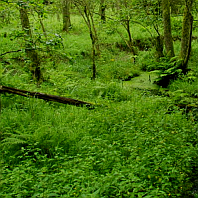22 February 2018
Taking advantage of the good weather, we have planned the fourth volunteering day of this winter next Sunday 25th, to work on the regeneration of the A Espenuca Wood.
Since the plot in which we are doing land stewardship is big (1.6 hectare) and quite steep, the work of clearing gorse, broom and bramble ―so that they do not hinder the growth of the native trees we had planted on the old eucalyptus wood― is slow. On the other hand, the elimination of the eucalyptus born from seed is quick, since it is easy to uproot them.
In case you would like to participate, please send us your data in advance (complete name, ID, date of birth and mobile number). Thus, we will be able to inform you on last minute changes, you will be covered by an accident insurance policy and you will facilitate organization. In section Contact you will find the necessary information.
Meeting point: Outpatient Clinic of Betanzos, where we can share cars.
Date: February 25th, 2018.
Time: We will be leaving at 9.30 a.m., coming back at 2.00 p.m.
14 February 2018
Our first public intervention this year will be on Wednesday next week in A Coruña.
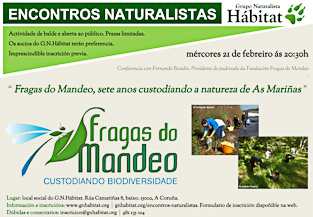 The Grupo Naturalista Hábitat has invited us to show our work at the Naturalist Meetings. Under this name they periodically organize conferences on different aspects of natural sciences, lectured by leading specialists. Therefore, we could not turn down this excellent opportunity to spread the word about the progress of our interventions among an audience so committed to nature conservation.
The Grupo Naturalista Hábitat has invited us to show our work at the Naturalist Meetings. Under this name they periodically organize conferences on different aspects of natural sciences, lectured by leading specialists. Therefore, we could not turn down this excellent opportunity to spread the word about the progress of our interventions among an audience so committed to nature conservation.
Place: Premises of the Grupo Naturalista Hábitat (Hábitat Naturalist Group), in Camariñas Street 8 (A Coruña).
Date: Wednesday, February 21st, 2018.
Time: 8.30 p.m.
Registration: In order to facilitate organization, please do register in advance.
19 January 2018
We have planned the first volunteering day of the year on Sunday 21st; we will go on with the regeneration of the native wood on the A Espenuca hill.
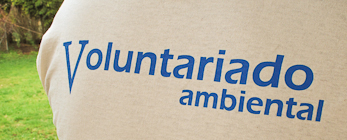 We do land stewardship on a 1.6 hectare plot just at the foot of the chapel, on which we are clearing gorse, brooms and bramble, so that the scrub doesn’t hamper the growth of native trees. We also cleared vegetation around the trees we had planted, since they are still very small, and we eliminated the eucalyptus trees born from seed (from those belonging to the old eucalyptus wood, only a few remained that had re-sprouted from stump). We started the work on November, 19th and we continued on December, 30th, within the framework of the A Espenuca Wood campaign.
We do land stewardship on a 1.6 hectare plot just at the foot of the chapel, on which we are clearing gorse, brooms and bramble, so that the scrub doesn’t hamper the growth of native trees. We also cleared vegetation around the trees we had planted, since they are still very small, and we eliminated the eucalyptus trees born from seed (from those belonging to the old eucalyptus wood, only a few remained that had re-sprouted from stump). We started the work on November, 19th and we continued on December, 30th, within the framework of the A Espenuca Wood campaign.
Should you like to participate, please send us your data in advance (complete name, ID, date of birth and mobile number). Thus, we will be able to inform you on last minute changes, you will be covered by an accident insurance policy and you will facilitate organization. In section Contact you will find the necessary information.
Meeting point: Outpatient Clinic of Betanzos, where we can share cars.
Date: January 21st, 2018.
Time: We will be leaving at 9.30 a.m., coming back at 2.00 p.m.
1 January 2018
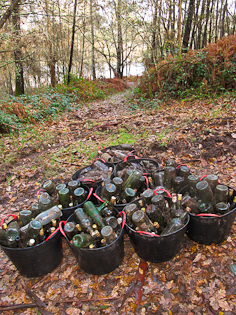 The best way to show commitment to the preservation of nature is to work for it every day of the year. This is how one of our volunteers sees it, so he made the most of his leisure time during these holidays to remove litter in the SAC natural heritage site Abegondo-Cecebre reservoir.
The best way to show commitment to the preservation of nature is to work for it every day of the year. This is how one of our volunteers sees it, so he made the most of his leisure time during these holidays to remove litter in the SAC natural heritage site Abegondo-Cecebre reservoir.
The volunteering day on the 16th, called by the Grupo Naturalista Hábitat (Hábitat Naturalist Group), aimed at sorting the types of litter present on the natural area, in order to provide data to the project Libera. But an issue remained unsolved: how much litter is there in total?
To make an estimate, our volunteer spent five days removing litter on the reservoir headwaters, formed by the River Mero, upstream the Seixurra Bridge. He filled sacks with the litter he could find on the reservoir floodable area (plastics, glass, tins, pottery, shoes, etc.), and piled them with other bigger items (three wheels and one battery). By their appearance, much of the litter may have been left there for decades. He devoted New Year’s Eve to remove 200 glass bottles thrown on a path by the reservoir. Finally, on New Year’s Day he transported and weighted the litter sacks, summing up a total of 602 kilos. 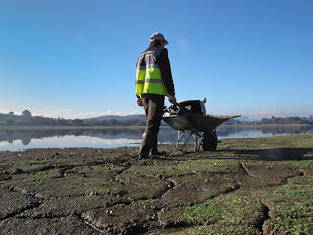 If this result is extrapolated to the whole extension of the protected natural site and adjacent paths, after applying correction factors, he estimated that there may be 4 tons of litter waiting to be removed.
If this result is extrapolated to the whole extension of the protected natural site and adjacent paths, after applying correction factors, he estimated that there may be 4 tons of litter waiting to be removed.
There is much to do for the environment of our area. The mere action of a single person implied that more than a ton of litter stopped contaminating Cecebre. The more volunteers we are, the more impact of our effort and the more area will be covered.
As a resolution for 2018, would you resolve to take care of nature?
Happy New Year!
27 December 2017
It is about to end a terrible year for the Galician woods. Thus, to bid farewell to 2017, nothing better than working on the regeneration of our woods.
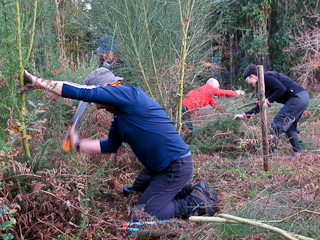 Meteorologists are announcing a short pause in the squalls, allowing a morning with smooth temperatures and partly cloudy sky. We are taking this opportunity to go up to A Espenuca, to continue the work we had started last November 19 on the 1,6 hectare plot in which we do land stewardship at the foot of the chapel. The aim is to eliminate the remaining eucalyptus trees and to clear away gorse, brooms and bramble, so that the scrub does not hinder the growth of the native trees. We will also have to clear the vegetation around the trees we had planted, because they are still very small.
Meteorologists are announcing a short pause in the squalls, allowing a morning with smooth temperatures and partly cloudy sky. We are taking this opportunity to go up to A Espenuca, to continue the work we had started last November 19 on the 1,6 hectare plot in which we do land stewardship at the foot of the chapel. The aim is to eliminate the remaining eucalyptus trees and to clear away gorse, brooms and bramble, so that the scrub does not hinder the growth of the native trees. We will also have to clear the vegetation around the trees we had planted, because they are still very small.
If you want to know in detail what we are doing at this wood, you can look up the section Fraga da Espenuca campaign on our website.
Should you like to participate, please send us your data in advance (complete name, ID, date of birth and mobile number). Thus, we will be able to inform you on last minute changes, you will be covered by an accident insurance policy and you will facilitate organization. In section Contact you will find the necessary information.
Meeting point: Outpatient Clinic of Betanzos, where we can share cars.
Date: December 30th, 2017.
Time: We will be leaving at 9.30 a.m., coming back at 2 p.m.
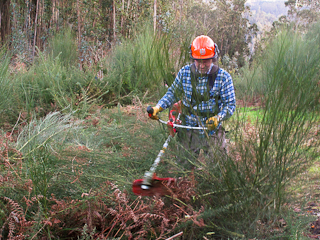 Post data: Just as forecasted by meteorologists, the twelve volunteers that got to A Espenuca enjoyed a wonderful morning. They got to complete the clearing of gorse and broom on the lower part of the plot, and uprooting some eucalyptus trees and Blackwood acacia. With this action on New Year’s Eve they showed their firm commitment to the conservation of our native woods. In early 2018 we will set a day to go on working on the rest of the plot.
Post data: Just as forecasted by meteorologists, the twelve volunteers that got to A Espenuca enjoyed a wonderful morning. They got to complete the clearing of gorse and broom on the lower part of the plot, and uprooting some eucalyptus trees and Blackwood acacia. With this action on New Year’s Eve they showed their firm commitment to the conservation of our native woods. In early 2018 we will set a day to go on working on the rest of the plot.
16 December 2017
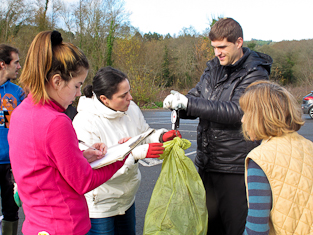 This morning we got to the protected natural heritage site SAC Encoro de Abegondo-Cecebre, as we were invited to participate in an environmental volunteering organized by the Grupo Naturalista Hábitat (Hábitat Naturalist Group).
This morning we got to the protected natural heritage site SAC Encoro de Abegondo-Cecebre, as we were invited to participate in an environmental volunteering organized by the Grupo Naturalista Hábitat (Hábitat Naturalist Group).
The selected location was the reservoir headwaters formed by the River Barcés, in the vicinity of As Táboas. Twelve volunteers quickly removed all the litter on the selected area. However, the slow and boring task was to classify it.
The aim was not to collect a great volume, but to characterize in detail the composition, origin and size of the litter, in order to provide this information to the Libera project which is being carried out by SEO/Birdlife and Ecoembes. These two organizations want to know in depth the littering phenomenon, the general dirtying due to the presence of litter everywhere, since it is severely affecting the environment.
25 November 2017
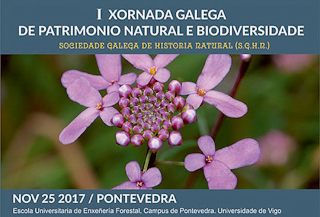 Today we have been in Pontevedra presenting the work of Fragas do Mandeo in a remarkable setting, the 1st Galician Conference on Natural Heritage and Biodiversity. It was organized by the Pontevedra’s section of the Sociedade Galega de Historia Natural (Galician Natural History Society) and took place at the University College of Forestry Engineering; it had the participation of 11 speakers who talked about plenty of topics, from forest fires to fauna monitoring software, as well as environmental information and problems caused by micro-plastics. It was a very interesting conference, attended by a large public, whose organizers are confident in its continuity.
Today we have been in Pontevedra presenting the work of Fragas do Mandeo in a remarkable setting, the 1st Galician Conference on Natural Heritage and Biodiversity. It was organized by the Pontevedra’s section of the Sociedade Galega de Historia Natural (Galician Natural History Society) and took place at the University College of Forestry Engineering; it had the participation of 11 speakers who talked about plenty of topics, from forest fires to fauna monitoring software, as well as environmental information and problems caused by micro-plastics. It was a very interesting conference, attended by a large public, whose organizers are confident in its continuity.
19 November 2017
This morning eleven volunteers visited the North slope of the A Espenuca hill to work on the 1.6 hectares plot in which we will be doing land stewardship for 50 years. Located at the foot of the chapel, it was two years ago when we started the process to transform the eucalyptus wood into a native wood.
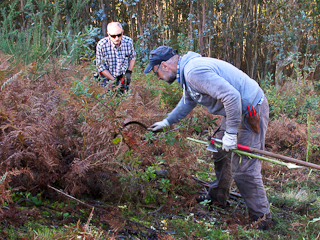 In the first half of the year we went over the elimination of the eucalyptus trees born from seed (only a few remained that had re-sprouted from stump). With the summer, the fern, gorse and broom made it difficult to locate and even to reach them. We could not clear all the scrub, as the drought makes it too easy for any spark from the weeding machine to set on fire. Nor was it advisable, since with this summer intense heat, the vegetation provides shade and damp to the trees that we had planted.
In the first half of the year we went over the elimination of the eucalyptus trees born from seed (only a few remained that had re-sprouted from stump). With the summer, the fern, gorse and broom made it difficult to locate and even to reach them. We could not clear all the scrub, as the drought makes it too easy for any spark from the weeding machine to set on fire. Nor was it advisable, since with this summer intense heat, the vegetation provides shade and damp to the trees that we had planted.
Today we took advantage of the sunny weather, grateful that the vegetation was not wet because of the dew. A volunteer completed the cleaning of the inner paths, which he had started a couple of days earlier. The rest of us were uprooting eucalyptus and cutting gorse and broom (some of them were more than two meters high).
Free from all that vegetation, the volunteers were able to find the trees we had planted and those that spontaneously grew from seed. At the beginning of the next spring the trees will grow straight without any problem. They also realized that the ground was covered by moss and low-lying vegetation, an excellent defence against erosion on such a steep slope. The improvement of the habitat can also be noticed in the fauna, since while they were working they found a salamander (Salamandra salamandra) and one common toad (Bufo spinosus).
There are still many days ahead to complete these important forestry works: Recovering a wood involves much more than simply planting trees. Should you like to participate in the next volunteering days and you are not on our mailing list yet, please contact us. In section Contact you will find detailed information.
29 October 2017
One month ago we celebrated the sixth Land Stewardship Week, during which the volunteers’ hard work produced really successful results. But it’s about time to undertake some pending tasks.
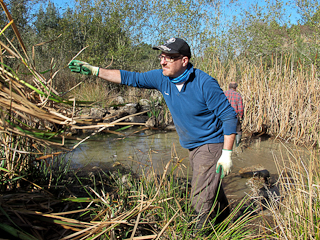 This morning ten volunteers went to work to O Catorce amphibian reserve. The main objective was to restore one of the pools. Taking advantage of the drought that lowered the water level, we were able to remove the excessive vegetation. Thus, the pool will keep part of its surface completely clear, enabling the diversity suitable to the ecological requirements of various species.
This morning ten volunteers went to work to O Catorce amphibian reserve. The main objective was to restore one of the pools. Taking advantage of the drought that lowered the water level, we were able to remove the excessive vegetation. Thus, the pool will keep part of its surface completely clear, enabling the diversity suitable to the ecological requirements of various species.
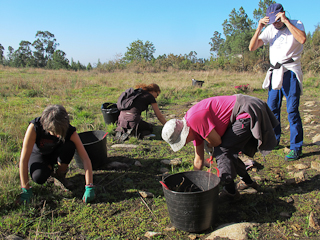 We also needed to check two exotic invasive species which weren’t eradicated yet. The volunteers eliminated the Canadian horseweed (Conyza canadensis) throughout the quarry, filling eleven 100-litre sacks. On the other hand, they were able to eliminate the tall flatsedge (Cyperus eragrostis) on the upper terrace. Depending on the evolution on that area, we will decide if it is feasible to eradicate it on the lower terrace, where it is very abundant.
We also needed to check two exotic invasive species which weren’t eradicated yet. The volunteers eliminated the Canadian horseweed (Conyza canadensis) throughout the quarry, filling eleven 100-litre sacks. On the other hand, they were able to eliminate the tall flatsedge (Cyperus eragrostis) on the upper terrace. Depending on the evolution on that area, we will decide if it is feasible to eradicate it on the lower terrace, where it is very abundant.
Finally, we cut the gorse on the West boundary with a weeding machine, as they were growing a lot, blocking the way.
12 October 2017
The sixth edition of Land Stewardship Week was a complete success, but now it’s over and nature still needs our efforts.
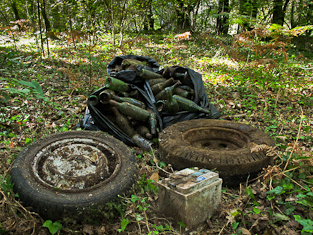 Taking advantage of today’s public holiday, one of our volunteers got to the River Mandeo to check if new exotic invasive species had reappeared on the stretch between the footbridge of Chelo and the Teixeiro Bridge, and at the same time, to remove the litter that is all too frequently thrown away on this beaten track.
Taking advantage of today’s public holiday, one of our volunteers got to the River Mandeo to check if new exotic invasive species had reappeared on the stretch between the footbridge of Chelo and the Teixeiro Bridge, and at the same time, to remove the litter that is all too frequently thrown away on this beaten track.
He located a few plants of montbretia and of small-leaf spiderwort, but looking for litter he was able to find it abundantly hidden on the wood near the path: 71 glass bottles, two tyres, one car battery and diverse types of rubbish which filled a 100-litre sack.
We all can do something for nature. If you would like to be informed on the next environmental volunteering days, please contact us. In section Contact you will find detailed information.
 The
The  We do land stewardship on a 1.6 hectare plot just at the foot of the chapel, on which we are clearing gorse, brooms and bramble, so that the scrub doesn’t hamper the growth of native trees. We also cleared vegetation around the trees we had planted, since they are still very small, and we eliminated the eucalyptus trees born from seed (from those belonging to the old eucalyptus wood, only a few remained that had re-sprouted from stump). We started the work on
We do land stewardship on a 1.6 hectare plot just at the foot of the chapel, on which we are clearing gorse, brooms and bramble, so that the scrub doesn’t hamper the growth of native trees. We also cleared vegetation around the trees we had planted, since they are still very small, and we eliminated the eucalyptus trees born from seed (from those belonging to the old eucalyptus wood, only a few remained that had re-sprouted from stump). We started the work on  The best way to show commitment to the preservation of nature is to work for it every day of the year. This is how one of our volunteers sees it, so he made the most of his leisure time during these holidays to remove litter in the SAC natural heritage site Abegondo-Cecebre reservoir.
The best way to show commitment to the preservation of nature is to work for it every day of the year. This is how one of our volunteers sees it, so he made the most of his leisure time during these holidays to remove litter in the SAC natural heritage site Abegondo-Cecebre reservoir. If this result is extrapolated to the whole extension of the protected natural site and adjacent paths, after applying correction factors, he estimated that there may be 4 tons of litter waiting to be removed.
If this result is extrapolated to the whole extension of the protected natural site and adjacent paths, after applying correction factors, he estimated that there may be 4 tons of litter waiting to be removed.  Meteorologists are announcing a short pause in the squalls, allowing a morning with smooth temperatures and partly cloudy sky. We are taking this opportunity to go up to A Espenuca, to continue the work we had started last
Meteorologists are announcing a short pause in the squalls, allowing a morning with smooth temperatures and partly cloudy sky. We are taking this opportunity to go up to A Espenuca, to continue the work we had started last  Post data: Just as forecasted by meteorologists, the twelve volunteers that got to A Espenuca enjoyed a wonderful morning. They got to complete the clearing of gorse and broom on the lower part of the plot, and uprooting some eucalyptus trees and Blackwood acacia. With this action on New Year’s Eve they showed their firm commitment to the conservation of our native woods. In early 2018 we will set a day to go on working on the rest of the plot.
Post data: Just as forecasted by meteorologists, the twelve volunteers that got to A Espenuca enjoyed a wonderful morning. They got to complete the clearing of gorse and broom on the lower part of the plot, and uprooting some eucalyptus trees and Blackwood acacia. With this action on New Year’s Eve they showed their firm commitment to the conservation of our native woods. In early 2018 we will set a day to go on working on the rest of the plot. This morning we got to the protected natural heritage site SAC Encoro de Abegondo-Cecebre, as we were invited to participate in an environmental volunteering organized by the
This morning we got to the protected natural heritage site SAC Encoro de Abegondo-Cecebre, as we were invited to participate in an environmental volunteering organized by the  Today we have been in Pontevedra presenting the work of Fragas do Mandeo in a remarkable setting, the 1st Galician Conference on Natural Heritage and Biodiversity. It was organized by the Pontevedra’s section of the
Today we have been in Pontevedra presenting the work of Fragas do Mandeo in a remarkable setting, the 1st Galician Conference on Natural Heritage and Biodiversity. It was organized by the Pontevedra’s section of the  In the first half of the year we went over the elimination of the eucalyptus trees born from seed (only a few remained that had re-sprouted from stump). With the summer, the fern, gorse and broom made it difficult to locate and even to reach them. We could not clear all the scrub, as the drought makes it too easy for any spark from the weeding machine to set on fire. Nor was it advisable, since with this summer intense heat, the vegetation provides shade and damp to the trees that we had planted.
In the first half of the year we went over the elimination of the eucalyptus trees born from seed (only a few remained that had re-sprouted from stump). With the summer, the fern, gorse and broom made it difficult to locate and even to reach them. We could not clear all the scrub, as the drought makes it too easy for any spark from the weeding machine to set on fire. Nor was it advisable, since with this summer intense heat, the vegetation provides shade and damp to the trees that we had planted.  This morning ten volunteers went to work to O Catorce amphibian reserve. The main objective was to restore one of the pools. Taking advantage of the drought that lowered the water level, we were able to remove the excessive vegetation. Thus, the pool will keep part of its surface completely clear, enabling the diversity suitable to the ecological requirements of various species.
This morning ten volunteers went to work to O Catorce amphibian reserve. The main objective was to restore one of the pools. Taking advantage of the drought that lowered the water level, we were able to remove the excessive vegetation. Thus, the pool will keep part of its surface completely clear, enabling the diversity suitable to the ecological requirements of various species. We also needed to check two exotic invasive species which weren’t eradicated yet. The volunteers eliminated the
We also needed to check two exotic invasive species which weren’t eradicated yet. The volunteers eliminated the  Taking advantage of today’s public holiday, one of our volunteers got to the River Mandeo to check if new exotic invasive species had reappeared on the stretch between the footbridge of Chelo and the Teixeiro Bridge, and at the same time, to remove the litter that is all too frequently thrown away on this beaten track.
Taking advantage of today’s public holiday, one of our volunteers got to the River Mandeo to check if new exotic invasive species had reappeared on the stretch between the footbridge of Chelo and the Teixeiro Bridge, and at the same time, to remove the litter that is all too frequently thrown away on this beaten track.
